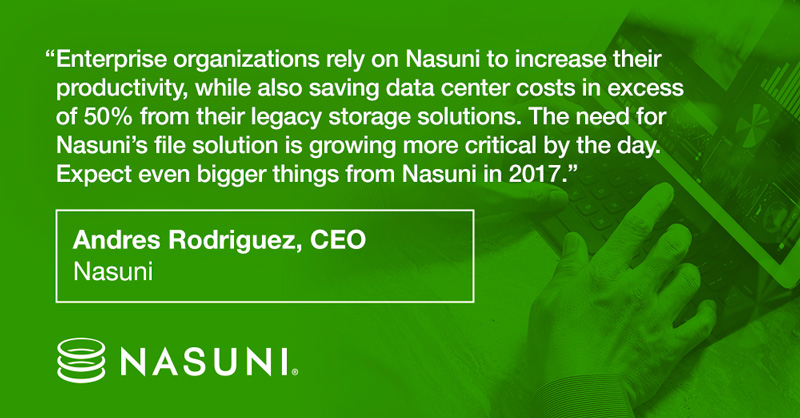Nasuni Announces Record 2016 Financial Results
Nasuni Announces Record 2016 Financial Results|Nasuni Announces Record 2016 Financial Results
February 7, 2017

Subscription Revenue Grows 92 Percent over 2015, Driven by Record Annual Contract Value (ACV) Bookings as Well as Existing Customer Capacity Expansion
Natick, Mass. – February 7, 2016 – Nasuni Corporation, the industry’s leading provider of cloud-based enterprise file services, today announced record results for its fiscal year ended December 31, 2016. Subscription revenue grew by 92 percent over the same period in 2015, driven by global enterprises’ critical need to solve the problems associated with exponential file growth.
Legacy storage solutions are unable to provide the fast global access, unlimited capacity, automatic data protection, and centralized management that large distributed organizations now require. Nasuni Enterprise File Services succeeds where legacy solutions have failed, because Nasuni has created UniFS, the world’s first file system native to the cloud. As a result, organizations can provide all employees around the globe with a fast connection to a file share that has no size limitations or capacity constraints. IT can back up data as often as every five minutes, and instantly recover files from any point in time, while administrators can manage file storage for the entire organization from a single, central console.

Highlights of Nasuni’s growth in 2016 over 2015 include:
- 130 percent growth in terabytes (TBs) under contract: More than 300 enterprise customers, including some of the world’s largest, and most data-intensive global enterprises, rely on Nasuni for their files – a singular driver of the dramatic increase in file capacity under contract.
- 99 percent growth in total subscription annual contract value (ACV) bookings: Annual Recurring Revenue (ARR) under contract increased 73 percent year-over-year, providing a foundation for projected 2017 subscription revenue growth of greater than 80 percent in 2017.
- 130 percent subscription dollar retention rate: Gross ACV customer churn was less than 5 percent for the year.
“Today’s global enterprise is embracing cloud strategies not only to save costs, but also to improve their businesses. Enterprise organizations such as TBWA rely on Nasuni to increase their productivity, while simultaneously saving data center costs in excess of 50 percent from their legacy storage solutions,” said Andres Rodriguez, CEO of Nasuni. “The need for Nasuni’s file solution is growing more critical by the day. Expect even bigger things from Nasuni in 2017.”
“Today’s global enterprise is embracing cloud strategies not only to save costs, but also to improve their businesses.”
“Our technology investments as well as our investments in sales and marketing paid big dividends during 2016,” said Scott Dussault, Nasuni Chief Operating Officer and Chief Financial Officer. “Our record subscription revenue resulted from our success in adding new customers to our platform and through our existing customers expanding their engagement with us by adding capacity. Our ‘land and expand’ strategy led to key customer wins during 2016, many of which are large global enterprise businesses who are using Nasuni for mission-critical workloads, and we are confident that the company is poised for growth in 2017 and beyond.”
About Nasuni
Nasuni provides an integrated solution to store, protect, share and access all enterprise files. Powered by UniFS®, the first cloud-native file system, Nasuni transforms enterprise file infrastructure. With unlimited scale, continuous versioning and high-performance distributed file access, Nasuni delivers the complete suite of Enterprise File Services — all at a significantly reduced cost. Nasuni is privately held and based in Boston, MA. For more information, visit www.nasuni.com.
Social Media Links
Twitter: www.twitter.com/nasuni
LinkedIn: https://www.linkedin.com/company/nasuni
The Nasuni Cloud Storage Blog: http://www.nasuni.com/blog